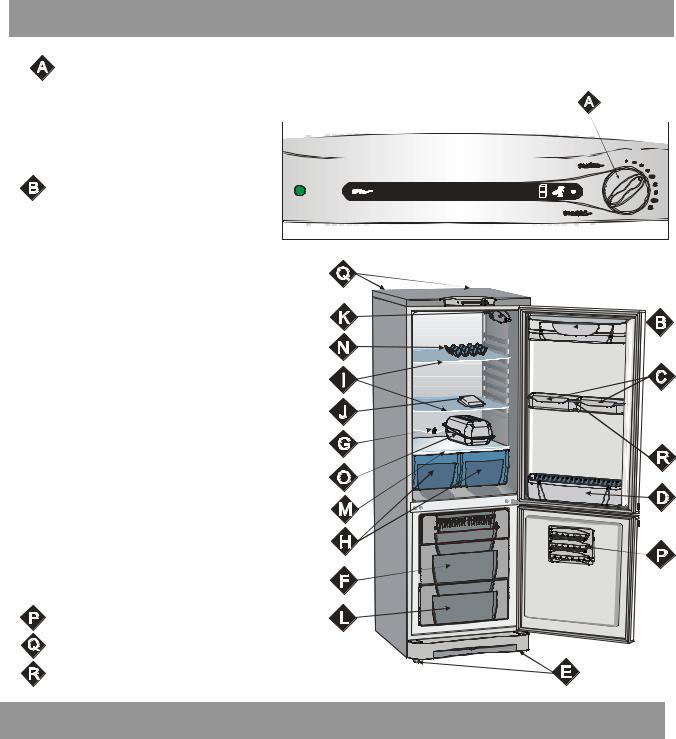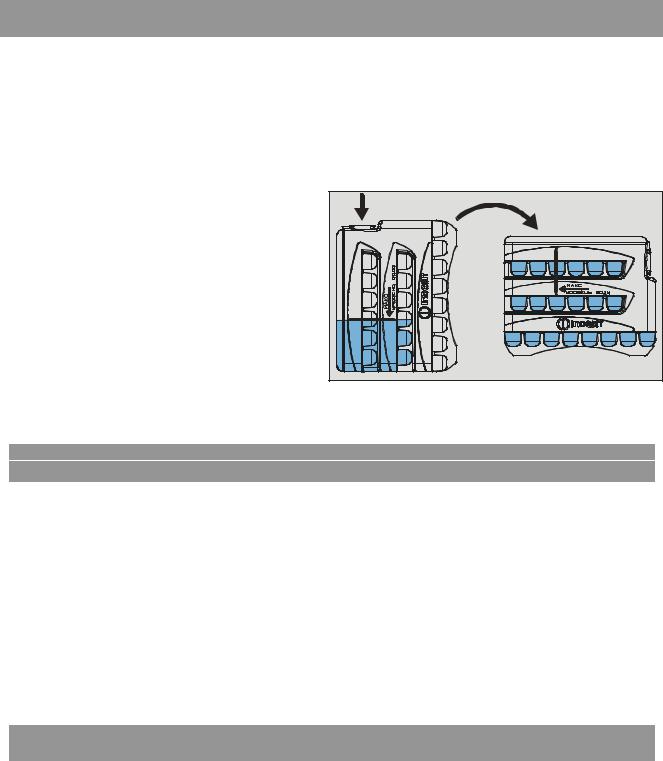Indesit C 132 NF G User Manual [ru]

С 132 NF G
Combi refrigerator-freezer
Installation and use
Комбинированный холодильник-морозильник Установка и использование

GB Combi refrigerator-freezer
Instructions for installation and use……………………………………….3
CIS Комбинированный холодильник-морозильник
Инструкции по установке и использованию………………………….10
To maintain the EFFICIENCY and SAFETY of this appliance, we recommend:
-call only the Service Centers authorized by the manufacturer
-always use original Spare Parts
Производитель оставляет за собой право без предупреждения вносить изменения в конструкцию, не ухудшающие эффективность работы оборудования.
-Некоторые параметры, приведенные в этой инструкции, являются ориентировочными:
-Производитель не несет ответственности за незначительные отклонения от указанных величин. 1

Safety - a good habit to get into.
ATTENTION
Read your manual carefully since it contains instructions, which will ensure safe installation, use and maintenance of your appliance.
Your Refrigerator is built to International safety standards (EN60) and has been awarded the European approval mark (IMQ) for conformity with UK electrical safety requirements. It also meets the EC standards on the prevention and elimination of readio interference (EC directive 87/308 - 02.06.89).
1. This appliance is designed to be used indoors and under no circumstances should it be installed outside even if protected by a roof. Leaving the appliance exposed to the rain and whether is exceedingly dangerous.
2.The appliance should be used only by adults and exclusively for storing foodstuffs in compliance with the instructions provided in this manual. Under no circumstances should children be allowed to operate, or tamper with, this product.
3.Do not attempt to operate or handle this appliance when barefoot, or with wet hands or feet.
4.It is highly recommended that you do not operate
this appliance by connecting it to the power supply with extensions or multiple socket plugs. If the refrigerator has been installed between two cabinets, make sure that the supply cord is not dangerously crimped or trapped beneath a heavy
object.
5. Never pull the cable or the appliance to remove the plug from the socket; this is exceedingly dangerous.
6.Do not touch the internal cooling elements, especially if your hands are wet, since you could burn or hurt yourself.
7.Before doing any cleaning, disconnect the appliance from the electricity (by pulling out the plug or turning off the general switch in your home); it is not sufficient to place the temperature regulation knob “off” to cut off the power.
8.Before disposing of your old appliance, remember to break or remove the lock as a safety measure to protect children who might lock themselves inside the appliance when playing. In addition, if the appliance is a new one with a lock, keep the key out of the reach of small children.
9.If your appliance is not operating properly, read the chapter entitled, “Trouble Shooting”, which might help you to resolve the problem, before calling an after-sales service center. Do not attempt to repair the appliance by tampering with the internal components.
10.If the power supply cord must be replaced, please contact one of our Customer Service Centers. In some cases, the connections are made using special terminals and in others a special tool must be used to access the connections.
11.Do not use electric appliances inside the compartment for food storage, if these are not those recommended by the manufacturer.
12. At the end of the functional life of your appliance – containing cyclopentane gas in the insulation foam and
gas R134a (tetraphtorethane) in the refrigeration circuit – the latter should made safe before being sent to the dump. For this operation, please contact your dealer or the Local Organisation in charge of waste disposal.
Installation
Proper installation of the appliance is essential to ensure the best and most efficient performance of your appliance.
Ventilation
The compressor and condenser generate heat and, therefore, need to be ventilated properly. Rooms with less than perfect ventilation are not very suited for installation of the appliance. Therefore, it should be installed in a room with
an opening (window or French window) that provides the appropriate amount of air re-circulation. It is also important that the room should not be too humid.
During installation, make sure not to cover or obstruct the grates that allow proper ventilation of the appliance. For proper ventilation of the appliance, you must leave:
-a space of at least 10 cm between the top part and any cabinets above it;
-a space of at least 5 cm between the sides of the appliance and any adjacent cabinets/walls.
Away from Heat
Avoid positioning the appliance in a place where it is
directly exposed to sunlight or near an oven, cook top or the like.
Levelling
The floor should be perfectly levelled; if not, you can adjust the feet at the front of the appliance.
Earthing
Before making the electrical connection, check that the voltage shown on the data plate, that you will find on the bottom left hand side of the appliance next to the crisper, corresponds to that of your mains and that the socket is earthed in conformity with all current electrical regulations. If the system is not earthed, the manufacturer declines all liability for consequent damages or losses. Do not use adapters or multiple sockets.
Check the power load
The electrical socket must support the maximum power load of the appliance shown on the data plate (on the bottom left hand side of the appliance next to the crisper).
Before plugging the appliance to the mains
Set the appliance upright and wait at least 3 hours before plugging the appliance into the mains to ensure proper performance.

A Closer Look
Thermostat knob for regulating |
Fig. 1 |
|
|
|
|
|
|||
the temperature |
|
|
|
|
|
||||
Use this knob to regulate the temperature of the refrig- |
|
|
|
|
|
|
|
||
erator. The following settings are available (fig. 1): |
|
|
|
|
|
|
|
||
off - The refrigerator is off; |
|
|
|
|
|
|
|
|
|
|
|
|
|
|
|
|
|
||
min - less cold; |
|
|
|
|
|
|
|
||
max - colder |
|
|
|
|
|
|
|
|
|
|
|
|
|
|
|
|
|
||
|
|
|
|
|
|
|
|
||
|
|
|
|
|
|
|
|
|
|
Hanging rack with transparent cover
 Small hanging rack
Small hanging rack
 Lower hanging rack with bottles holder
Lower hanging rack with bottles holder
 Adjustable feet
Adjustable feet
 Container for freezing and frozen food storage
Container for freezing and frozen food storage
 Drainage system for thawn water
Drainage system for thawn water
 Fruit and vegetable drawer
Fruit and vegetable drawer
 Removable height adjustable shelves
Removable height adjustable shelves
 Butter dish with cover
Butter dish with cover
 Lamp
Lamp
 Container for frozen food storage
Container for frozen food storage
 Glass tray
Glass tray
 Eggs tray
Eggs tray
 Miat container
Miat container
Ice containe
Rear stoppers (Fig 4)
Hanging rack holder
Setting up Your Appliance
ATTENTION
After transport set the appliance upright and wait at least 3 hours before plugging the appliance into the mains to ensure proper performance.
Use these average temperature settings to ensure optimum performance and to save energy.
Before storing food in your refrigerator, wipe the interior with a solution of warm water and bicarbonate of soda. After having plugged the appliance into the socket, make sure that the refrigerator lamp has turned on. Then turn the thermostat knob “A” to setting “medium”.
After a couple of hours, you can place fresh food in the refrigerator.
3

How to use the refrigerator compartment...
The thermostat automatically regulates the temperature inside the appliance
Min = less cold Max = colder
It is recommended that a medium setting be used. To increase the amount of space, optimize arrangement and improve appearance, this appliance has a
“cooling area” located within the back panel of the refrigerator compart-ment.
When the appliance is operating, this panel may be covered with frost or droplets of water depending on
whether the compressor is operating or not at a set time. Do not be concerned about this! The refrigerator is operating normally.
If the thermostat knob is positioned on higher settings while the refrigerator is heavily filled and the ambient temperature is high, the appliance may run continuously, resulting in the formation of frost on the back cooling area. This will lead to an increase in energy consumption.
To avoid this situation, just turn the thermostat knob to a lower setting so that the appliance defrosts automatically.
Storing food in the Refrigerator Compartment
Food |
Storage time |
Location in the Refrigerator |
|
|
|
Wrapped meat and cleavec fish |
2 or 3 days |
On the shelf above the vegetable container |
(use plastic wrap or pack in plastic bags) |
|
(which is the coldest area). |
Fresh cheese |
3 or 4 days |
On the shelf above the vegetable container |
|
|
(which is the coldest area). |
Eggs |
1 month |
In special egg tray on any shelf |
Butter, margarine |
1 week |
On any shelf |
Cooked or precooked food (placer in air-tight contain- |
3 or 4 days |
On any shelf |
ers and when cool store in refrigerator) |
|
|
Sausages, salami, sandwich meats in general, fresh |
3 or 4 days |
On any shelf |
pasta, custards, puddings, chocolates, cream pastries, |
|
|
bread, dry pastries, red tomatoes |
|
|
Bottled products, milk, drinks, yoghurt |
|
On special door shelves |
What Should Not be Stored in the Refrigerator
Garlic (transmits odour), onions and leeks. Bananas (they will turn black).
Citrus fruits.
Potatoes and root vegetables (store in dark, dry places). - Within the refrigerator compartment, the air circulates naturally, with the colder air falling down because it is heavier. This is the reason why meat and cheeses should be placed above the vegetable container.
-Please follow our instructions carefully on maximum storage time: any food, even the freshest, will not remain edible for any extended amount of time.
-Do not place liquids in containers without covering them because this will lead to an increase in the level of moisture within the refrigerator, causing the formation of frost.
-Remember to cool hot food before storing otherwise the temperature inside the appliance will increase, causing the compressor to work harder and use more energy.
-Contrary to popular belief, cooked foods are not stored any longer than raw food.
-The refrigerator compartment is equipped with conven-
ient, removable shelves which can be adjusted for height using the shelf guides. This allows you to place even large containers and foodstuffs in the refrigerator.
- Be careful not to place containers (plastic or glass), food or other objects in direct contact with the cooling area of the back wall of the refrigerator. This could harm the food, in-crease energy consumption and facilitate the formation of condensate (on food, containers, etc.).
4

How to use the freezer compartment...
Consult a specialized manual when packaging foods for freezing.
-Remember that you should never re-freeze products you have allowed to thaw, even if only partially: cook the food, then either eat (within 24 hours) or refreeze it.
-When freezing fresh foods, remember that they should not touch other previously frozen or deep frozen foods. Place the food that you wish to freeze in the top compartment where the temperature will fall below -18°C, which is ideal
for freezing food properly. Remember that proper con- ser-vation depends on the speed of freezing.
-Do not open the freezer door during freezing.
-Freeze only the quantities (in kg) shown on the data plate on the left of the container.
-For the best conservation and defrosting, remember to freeze small portions; this will ensure rapid and uniform freezing. Mark package with a description of the contents and the date it was frozen.
-In the case of power failure or breakdown, do not open the freezer door. This will help maintain the tem-
perature inside the freezer ensuring that foods are conserved for at least 17 hours.
- Do not store full bottles in the freezer since they
could explode when they freeze. (Remember that liquids in crease in volume when frozen)
-If the room temperature remains below 14°C for an extended period of time the freezer will not reach the temperatures required for storage, and storage life will be shorter. In this case, frozen foodstuffs should be used within a relatively short period of time.
-Fill the ice container so that they are no more indication of line.
Energy Saving Tips
- Install the appliance correctly
This means that the appliance should be installed away from heat sources or direct sunlight in a well ventilated room.
- Correct temperature settings
Set the refrigerator or freezer temperature knob to one of the medium settings. Very low temperatures will not only consume a great deal of energy but will neither improve or lengthen the storage life of the food. Excessively low temperature may in fact spoil vegetables, cold meats and cheese.
- Do not overfill your appliance
Remember that proper storage of food requires good air circulation. Overfilling your appliance will prevent
this circulation and overwork the compressor.
- Shut the doors
Open your appliance only when strictly necessary; remember that every time you open the door most of the cold air will be lost.
The motor will have to run, and consume energy, to restore the correct temperature.
- Check the door gaskets
keep the gaskets clean and soft so that they fit closely against the door to ensure that no cold air is lost.
- Never store hot foods
A container of hot food in the refrigerator will increase the temperature significantly; allow food to cool to room temperature before storing.
Frozen food storage
Meat and fish
Food |
Wrapping |
Tenderising |
Storage |
Thawings Time |
|
|
(days) |
(month) |
|
Beef Roast |
Tinfoil |
2/3 |
9/10 |
Not required |
Lamb |
Tinfoil |
1 / 2 |
6 |
Not required |
Pork Roast |
Tinfoil |
1 |
6 |
Not required |
Veal Roast |
Tinfoil |
1 |
8 |
Not required |
Veal/Pork Chops |
Each piece wrapped in cling wrap and then in tin- |
|
6 |
Not required |
|
foil (4 to 6 slices) |
|
|
|
Minced Meat |
Each piece wrapped in cling wrap and then in tin- |
|
6 |
Not required |
|
foil (4 to 6 slices) |
|
|
|
5
